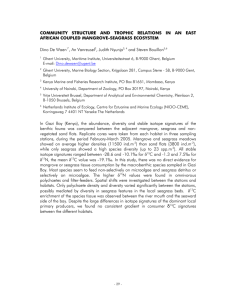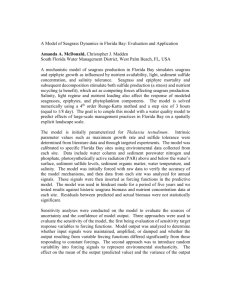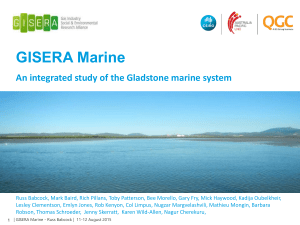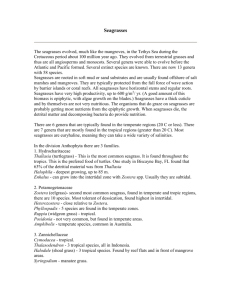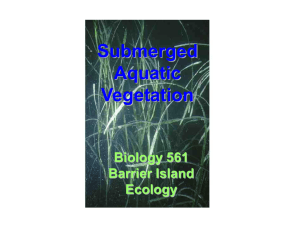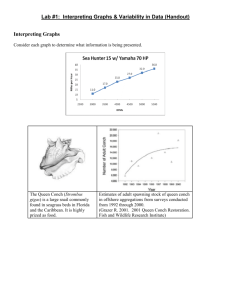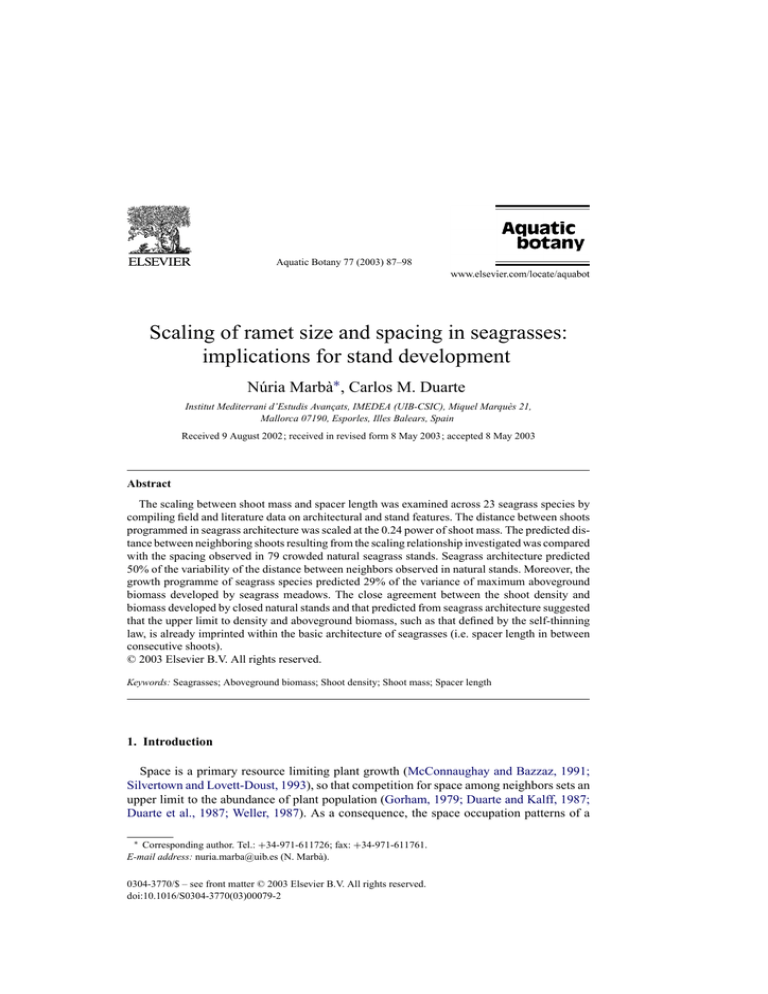
Aquatic Botany 77 (2003) 87–98
Scaling of ramet size and spacing in seagrasses:
implications for stand development
Núria Marbà∗ , Carlos M. Duarte
Institut Mediterrani d’Estudis Avançats, IMEDEA (UIB-CSIC), Miquel Marquès 21,
Mallorca 07190, Esporles, Illes Balears, Spain
Received 9 August 2002; received in revised form 8 May 2003; accepted 8 May 2003
Abstract
The scaling between shoot mass and spacer length was examined across 23 seagrass species by
compiling field and literature data on architectural and stand features. The distance between shoots
programmed in seagrass architecture was scaled at the 0.24 power of shoot mass. The predicted distance between neighboring shoots resulting from the scaling relationship investigated was compared
with the spacing observed in 79 crowded natural seagrass stands. Seagrass architecture predicted
50% of the variability of the distance between neighbors observed in natural stands. Moreover, the
growth programme of seagrass species predicted 29% of the variance of maximum aboveground
biomass developed by seagrass meadows. The close agreement between the shoot density and
biomass developed by closed natural stands and that predicted from seagrass architecture suggested
that the upper limit to density and aboveground biomass, such as that defined by the self-thinning
law, is already imprinted within the basic architecture of seagrasses (i.e. spacer length in between
consecutive shoots).
© 2003 Elsevier B.V. All rights reserved.
Keywords: Seagrasses; Aboveground biomass; Shoot density; Shoot mass; Spacer length
1. Introduction
Space is a primary resource limiting plant growth (McConnaughay and Bazzaz, 1991;
Silvertown and Lovett-Doust, 1993), so that competition for space among neighbors sets an
upper limit to the abundance of plant population (Gorham, 1979; Duarte and Kalff, 1987;
Duarte et al., 1987; Weller, 1987). As a consequence, the space occupation patterns of a
∗ Corresponding author. Tel.: +34-971-611726; fax: +34-971-611761.
E-mail address: nuria.marba@uib.es (N. Marbà).
0304-3770/$ – see front matter © 2003 Elsevier B.V. All rights reserved.
doi:10.1016/S0304-3770(03)00079-2
88
N. Marbà, C.M. Duarte / Aquatic Botany 77 (2003) 87–98
species are key traits constraining their competitive ability and the density and biomass of
closed stands.
Clonal plants occupy space by reiterating shoots spaced along their growing rhizomes or
stolons (Bell and Tomlinson, 1980; Bell, 1991). The spacing between consecutive shoots
along the rhizome is very conservative within a seagrass species (e.g. Duarte, 1991; Marbà
and Duarte, 1998), as expected from its tight genetic control in clonal plants (Gottileb,
1986). As a result, the space occupation by clonal plants is tightly regulated and easily
modelled (Smith and Palmer, 1976; Bell, 1979; Bell et al., 1979; Bell and Tomlinson, 1980;
Duarte, 1995, Callaghan et al., 1990; Klimes, 1992; Cain et al., 1996; Marbà and Duarte,
1998). The spacer length, i.e. the length of rhizome in between consecutive seagrass shoots,
sets a minimum distance between neighboring shoots in a stand. Moreover, the negative
relationship between shoot mass and density in land (Gorham, 1979) and aquatic (Duarte
and Kalff, 1987) plant stands, suggests that spacer length and shoot mass in clonal plants
might be positively related. Despite major progress in plant allometry (Niklas, 1994; Duarte,
1991; Marbà and Duarte, 1998), the existence of scaling laws between shoot mass and spacer
length is yet to be demonstrated for clonal plants, including seagrasses. The demonstration
of a negative relationship between spacer length and the rhizome diameter, a descriptor
of size, of seagrasses (Marbà and Duarte, 1998) suggests that spacer length may also be
scaled to shoot mass. Such scaling law, if confirmed, would have major implications for the
resulting structure and space occupation by seagrass stands.
We examine here the scaling between shoot mass and spacer length of seagrass species.
We then use the allometric relationship between shoot mass and spacer length of seagrass
species to compare the distance between neighboring shoots predicted by this relationship
with the spacing observed in natural closed natural seagrass stands. Lastly, we explore the
implications of the scaling laws demonstrated for the biomass development of crowded
seagrass stands, and its relationship with expectations resulting from the self-thinning law.
These goals are addressed on the basis of published estimates of the architecture and stand
structure of a broad range of seagrass species, appended with our own measurements,
which allow us to extend the range of species examined and, therefore, the generality of
our findings.
2. Methods
Data on seagrass spacer length (i.e. rhizome) and shoot mass (as dry mass, desiccated
overnight at 80 ◦ C) were compiled from the literature (Table 1), and amended for Cymodocea
nodosa, Posidonia oceanica and Ruppia maritima stands with our own estimates. We used
shoot mass values of temperate species measured during summer, the time of the year when
shoots are the heaviest. Because seagrass spacer length and shoot mass was examined for a
single population for most of the species, we averaged the estimates of architectural features
per species when available for several stands.
Another data set compiling published literature reports on the shoot density and aboveground biomass of closed seagrass stands at the time of the seasonal maximum aboveground
biomass was also built (Table 2). The average distance between neighbor shoots in the stands
was estimated by first calculating the area (m2 ) per shoot (i.e. shoot per density), and then
N. Marbà, C.M. Duarte / Aquatic Botany 77 (2003) 87–98
89
Table 1
Seagrass species included in the data base compiling architectural estimates (i.e. shoot mass and rhizome length
between connected shoots)
Species
Location
Reference
Number of
stands
Amphibolis antarctica
Amphibolis griffithii
Cymodocea serrulata
West Australia
West Australia
The Philippines
Marbà and Walker, 1999
Marbà and Walker, 1999
Vermaat et al., 1995
Cymodocea nodosa
East Spain
Portugal
Duarte, unpublished
Cunha, 1994
15
5
Cymodocea rotundata
Enhalus acoroides
Halodule uninervis
Halodule wrightii
Halophila ovalis
Heterozostera tasmanica
Posdonia angustifolia
Posidonia australis
Posidonia oceanica
The Philippines
The Philippines
The Philippines
Mexican Caribbean
The Philippines
West Australia
West Australia
West Australia
East Spain
1
1
1
1
1
1
1
1
29
Posidonia sinuosa
Ruppia maritima
Syringodiumfiliforme
Syringodium isoetzfolium
Thalassia hemprichii
Thalassia testudinum
Thalassodendron ciliatum
Thalassodendron pachyrrizum
Zostera marina
Zostera noltii
West Australia
Southwest Spain
Mexican Caribbean
The Philippines
The Philippines
Mexican Caribbean
Kenya
West Australia
East Spain
East Spain
Vermaat et al., 1995
Vermaat et al., 1995
Vermaat et al., 1995
Gallegos et al., 1994
Vermaat et al., 1995
Marbà and Walker, 1999
Marbà and Walker, 1999
Marbà and Walker, 1999
Marbà et al., 1996a; Marbà
et al., unpublished
Marbà and Walker, 1999
Marbá, unpublished
Gallegos et al., 1994
Vermaat et al., 1995
Vermaat et al., 1995
Gallegos et al., 1993
Duarte et al., 1996
Marbà and Walker, 1999
Marbà et al., 1996a,b
Marbà et al., 1996a,b
1
1
1
2
1
1
1
1
3
1
1
1
1
computing the average distance between neighbor shoots (dn , m) as:
area 1/2
dn = 4 ×
π
These calculations, which assume that each shoot is in the center of a circular individual
surface, represented the more parsimonious approach and yielded results similar (i.e. not
statistically different) to those using more complex tessellation.
The scaling between spacer length (Y) and shoot mass (X) was described by fitting allometric equations (cf. Niklas, 1994) of the form Y = a × Xb using least squares linear
regression analyses on log-transformed variables.
3. Results
Seagrass spacer length and shoot mass data were compiled for 72 seagrass stands, encompassing 23 seagrasses species, growing in along the Spanish, Portuguese, Mexican
90
N. Marbà, C.M. Duarte / Aquatic Botany 77 (2003) 87–98
Table 2
Sources of data on shoot density and aboveground biomass at the seasonal peak of aboveground biomass in seagrass
meadows
Species
Location
Reference
Amphibolis antarctica
West Australia
Walker and McComb, 1988
Number of
stands and/or
seasons
1
Cymodocea nodosa
Northeast Spain
Adriatic Sea
Northeast Spain
Southeast Spain
Cebrián et al., 1997
Guideti et al., 2001
Peduzzi and Vukovic, 1990
Pérez, 1989
Terrados, 1991
1
1
3
3
2
Cymodocea rotundata
Papua New Guinea
Brouns, 1987
1
Cymodocea serrulata
Papua New Guinea
North Australia
Brouns, 1987
Moriarty et al., 1990
1
1
Enhalus acoroides
Halodule uninervis
Papua New Guinea
Papua New Guinea
Brouns and Heijs, 1986
Brouns, 1987
2
1
Halodule wrightii
South Texas, USA
South Texas, USA
Dunton, 1996
Dunton, 1990
8
3
Halophila ovalis
Papua New Guinea
West Australia
Brouns, 1987
Hilliman et al., 1995
1
5
Heterozostera tasmanica
South Australia
Chile
Bulthuis and Woelkerling, 1983
Phillips et al., 1983
4
1
Posidonia oceanica
Northeast Spain
France
France
Adriatic Sea
France
Cebrián et al., 1997
Thelin and Giorgi, 1984
Bay, 1984
Guideti et al., 2001
Thelin and Giorgi, 1984
Ott, 1980
1
1
1
1
2
1
Ruppia maritima
Syringodium isoetifolium
Thalassia hemprichii
Texas, USA
Papua New Guinea
Papua New Guinea
Dunton, 1990
Brouns, 1987
Brouns, 1987
2
1
1
Thalassia testudinum
Florida, USA
South Texas, USA
Zieman, 1975
Kaldy and Dunton, 2000
1
4
Zostera capricorni
South Australia
Larkum et al., 1984
1
Zostera marina
Japan
Denmark
Northeast Spain
Adriatic Sea
Baja California, México
France
The Netherlands
Denmark
Virginia, USA
Denmark
East Canada
Denmark
Washington, USA
Aioi, 1980
Wium-Andersen and Borum, 1984
Cebrián et al., 1997
Guidetti et al., 1997
Ibarra-Obando, 1989
Jacobs, 1979
Nienhuis and de Bree, 1980
Olesen and Sand-Jensen, 1994
Orth and Moore, 1986
Pedersen, 1990
Robertson and Mann, 1984
Sand-Jensen, 1975
Thom, 1990
4
1
1
1
1
1
1
1
3
1
1
1
3
Zostera noltii
Northeast Spain
The Netherlands
Cebrián et al., 1997
Vermaat and Verhagen, 1996
1
2
N. Marbà, C.M. Duarte / Aquatic Botany 77 (2003) 87–98
91
Fig. 1. The relationship between the spacer length and the shoot mass of seagrasses: Amphibolis sp. (䊏); Cymodocea sp. (䊉); Enhalus acoroides (䊐); Halodule sp. (䊊); Halophila ovalis (+); Heterozostera teasmanica
(×); Posidonia sp. (); Ruppia maritima (䉱); Syringodium sp. ( ); Thalassia sp. (夹); Thalassodendron sp. ();
Zostera sp. (䉲). The solid line represents the fitted regression equation (Eq. (1)). The sources of these data are
compiled in Table 1.
Caribbean, The Philippines, western Australia, and Kenyan coasts (Table 1). Shoot mass and
spacer length spanned four and one orders of magnitude, respectively, among the seagrass
stands investigated (Fig. 1). The coefficient of variation of spacer length within individual
stands, which reflects the plasticity in this trait, averaged 66% (range 25–133%). About 40%
of the variability in spacer length (ds , m) among the species investigated was associated
to the wide differences in shoot mass among the seagrass examined. Regression analysis
revealed that seagrasses produce consecutive shoots further apart along their rhizomes as
shoot mass (W, g DW) increased (Fig. 1), as described by the equation:
ds = 0.059 W 0.24±0.05
N = 23;
P < 0.0005;
(1)
R2 = 0.46
which shows the spacer length connecting consecutive shoots along the rhizome to increase
as the 1/4 power of shoot mass.
Field estimates on aboveground biomass and shoot density during seasonal peak biomass
were obtained for 79 natural closed stands, encompassing 17 seagrass species (Table 2). The
distance between neighbor shoots (dn ) in natural seagrass stands at the time of peak biomass
was scaled to the 0.29 (±0.03) power of shoot mass (Fig. 2a), which was remarkably close
(t-test, H0 : slope = 0.24, intercept = 0.059; P > 0.95) to the scaling between the spacer
92
N. Marbà, C.M. Duarte / Aquatic Botany 77 (2003) 87–98
Fig. 2. (A) The relationship between the distance between neighbor shoots during the maximum seasonal aboveground development in monospecific stands of seagrasses. The solid line represents the fitted regression equation:
distance = 0.06 shoot mass0.29 (±0.03) , R2 = 0.50, P < 0.00001, n = 79. The sources of these data are compiled
in Table 2. (B) Relationship between the distance between neighbor shoots predicted from plant architecture using
Eq. (1) (X-axis) and that observed in the seagrass meadows during maximum seasonal aboveground development
(Y-axis). The solid line represents the 1:1 relationship between predicted and observed estimates. Dashed lines
represent the 95% confidence limits of predicted values.
N. Marbà, C.M. Duarte / Aquatic Botany 77 (2003) 87–98
93
length (ds ) and shoot mass for consecutive shoots along their rhizomes (i.e. Fig. 2b). Indeed,
there was a close relationship between the observed distance between neighbor shoots in
natural stands and that predicted from shoot mass using Eq. (1) (R2 = 0.50), with only two
of the stands having distances significantly different from those predicted by the architecture
(Fig. 2b).
The non-linear increase of spacer length with shoot size suggests that the ground area
per unit shoot mass of ideal closed seagrass stands should increase slower as the plants
develop larger shoots (i.e. As ∼ Ds2 ∼ (W 1/4 )2 ∼ W 1/2 ). This was confirmed by the
analysis of the ground area per shoot in the natural stands examined (i.e. scaling exponent
between As and W = 0.57 ± 0.06, R2 = 0.50). Similarly, the biomass (B, g DW m2 )
developed by an ideal seagrass stand (i.e. one that preserves the average distance between
neighbors equal to the spacer length) could be calculated as the ratio of the shoot mass and
the ground area per shoot, and is, therefore, expected to scale as W1/2 (i.e. B = WA−1
s =
W (W 1/2 )−1 = W 1/2 ). Hence, the biomass of dense seagrass stands developed from the
simple iteration of their spacing between connected shoots is, therefore, predicted to increase with increasing shoot mass. This prediction was also consistent with the scaling
of aboveground biomass and shoot mass in the natural seagrass stands (scaling exponent
between B and W = 0.39 ± 0.06, R2 = 0.29; Fig. 3a), and allowed the prediction of the
biomass of closed seagrass stands from allometric equations based on seagrass architecture
(Fig. 3b).
4. Discussion
Our results confirm the hypothesized relationship between the spacer length and the
shoot mass of seagrass species. The relationship, however, contained substantial scatter,
which may partially result from morphologically plasticity. Intraspecific plasticity of spacer
length has been demonstrated for Posidonia oceanica (Marbà et al., 1996a,b), and Cymodocea nodosa (Duarte unpublished results), where the spacing between shoots along
rhizomes may vary up to four-fold within a species. The intraspecific plasticity in spacer
length has been shown to be of adaptative significance in clonal plants, allowing the plants
to respond to spatial variability in resources (Slade and Hutchings, 1987a,b; Sutherland,
1987).
The relationship between spacer length and shoot mass was similar to that between the
realized average distance between neighbor shoots and shoot mass in natural seagrass stands.
This remarkable similarity strongly indicates that the internal packaging of shoots within
closed seagrass stands is largely the result of the basic growth programme of these clonal
plants, so that the allometric scaling between spacer length and shoot mass in preserved in
the distance between neighbor shoots in developed, closed seagrass stands. This similarity
is remarkable provided the broad range of species included in the analysis.
The results obtained suggest that the basic clonal architecture of seagrass species, imprinted on the spacing of shoots along their rhizomes, is projected onto developing stands
during growth. The clonal architecture of seagrass allows the prediction of the structure
of ideal stands where the area and biomass per capita is not significantly different to
that maintained in the natural stands during crowding conditions. The observation that
94
N. Marbà, C.M. Duarte / Aquatic Botany 77 (2003) 87–98
Fig. 3. (A) The relationship between the aboveground biomass (B) and individual shoot mass (W) at the time
of maximum seasonal aboveground development in seagrass stands. The solid line represents the regression
equation: B = 389 W0.39 (±0.06) . The sources of these data are compiled in Table 2. (B) The relationship between
the aboveground biomass of closed seagrass stands predicted from the monotonous iteration of their architecture
and that observed in the field during maximum seasonal aboveground development. The solid line represents the
1:1 relationship between predicted and observed estimates.
N. Marbà, C.M. Duarte / Aquatic Botany 77 (2003) 87–98
95
the upper limit to plant abundance of closed seagrass stands is similar to that predicted
from the simple iteration of the spacing between connected shoots, assigns a dominant role
to the clonal architecture of seagrasses in the configuration of their packaging in closed
stands.
The scaling between the maximum biomass realized in closed seagrass stands is similar to that predicted from the monotonous iteration of their shoots following the growth
programme imprinted onto their basic architecture. The resulting shoot density of natural
seagrass stands is similar to the shoot weight-dependent upper boundary to plant abundance
described for even-aged populations (Gorham, 1979, Duarte and Kalff, 1987, Niklas, 1994).
Indeed, the increase in maximum stand biomass with increasing shoot weight demonstrated
here is similar to the square root power scaling of shoot mass to aboveground biomass predicted by the self-thinning law (Weller, 1987), and departs from the law of constant yield,
which would have resulted in a linear scaling between biomass and shoot mass (Harper,
1977). Whether clonal plants undergo self-thinning during the development of closed stands
has been subject to debate, for the structure of close stands of clonal plants has been often shown to conform to the predictions derived from this law (Hutchings, 1979; Pitelka,
1984, Duarte and Kalff, 1987), as also indicated here (Fig. 3a), while the self-thinning
law involves mortality as the stands develop, which does not make evolutionary sense for
clonal plant. Our finding that the scaling between aboveground biomass and shoot mass
described by the self-thinning law is already built onto the basic architecture of seagrasses
(Fig. 3b) does suggest a possible explanation to reconcile these opposing views, for it
does suggest that seagrasses can reach the upper boundary to shoot mass described by
the self-thinning law without undergoing density-dependent mortality (Hutchings, 1979;
Olesen and Sand-Jensen, 1994; Room and Julien, 1994). Our results do, therefore, suggest that the upper limits to density and aboveground biomass defined by the self-thinning
law are already imprinted within the basic clonal architecture of seagrasses (i.e. spacer
length in between consecutive shoots). Moreover, crowded stands of clonal plants may
remain at the upper limit to density and biomass by decreasing shoot recruitment or rhizome growth (Hutchings, 1979; Schmid, 1990) or shoot size (Pitelka, 1984) once the limit is
reached, thereby avoiding competition for space through the physiological integration of the
clone.
In summary, the results obtained demonstrate the existence of an allometric scaling
between spacer length and shoot weight in seagrasses that is preserved on the average density
between neighbors of the stands they form. The close agreement between the aboveground
biomass developed by closed natural seagrass stands and that predicted from the monotonous
iteration of their architecture demonstrates that the structure of the stands seagrass develop
is, to a large extent set by the growth program imprinted in their architecture, and explains the
observation of size-dependent differences in the maximum aboveground biomass developed
by different species (Duarte and Chiscano, 1999). The minimum distance between neighbors
allowing shoot survivorship and the upper limit to the aboveground biomass of seagrass
stands is, therefore, programmed within their architecture. This finding suggests that the
efficient occupation of space must be a strong component of fitness and, thus, a main factor
in the evolution of seagrasses, and provide additional evidence of the power of allometric
approaches (Duarte, 1991; Niklas, 1994; Marbà and Duarte, 1998) for the comparative
analyses of seagrass ecology.
96
N. Marbà, C.M. Duarte / Aquatic Botany 77 (2003) 87–98
Acknowledgements
We are grateful to A.R. Watkinson for enlightening discussions during the course of this
work. We thank K. Sand-Jensen, M.A. Hemminga and M.A. Mateo for their comments
on previous versions of the manuscript. This is a contribution to the project Monitoring
and Management of European Seagrass Beds (contract #EVK3-CT-2000-00044) of the
European Commission.
References
Aioi, K., 1980. Seasonal changes in the standing crop of the eelgrass (Zostera marina L.) in Odawa Bay, central
Japan. Aquat. Bot. 8, 343–354.
Bay, D., 1984. A field study of the growth dynamics and productivity of Posidonia oceanica (L.) Delile in Calvi
Bay. Aquat. Bot. 20, 43–64.
Bell, A.D., 1979. The hexagonal branching pattern of rhizomes of Alpinia speciosa L. (Zingieraceae). Ann. Bot.
43, 209–223.
Bell, A.D., Tomlinson, P.B., 1980. Adabtative architecture in rhizomatous plants. Bot. J. Lin. Soc. 80, 125–160.
Bell, A.D., Roberts, D., Smith, A., 1979. Branching patterns: the simulation of plant architecture. J. Theor. Biol.
81, 351–375.
Brouns, J.J.W.M., 1987. Growth patterns of some Indo-West-Pacific seagrasses. Aquat. Bot. 28, 39–61.
Brouns, J.J.W.M., Heijs, F.M.L., 1986. Production and biomass of the seagrass Enhalus acoroides (L.f.) Royle
and its epiphytes. Aquat. Bot. 25, 21–45.
Bulthuis, D.A., Woelkerling, W.J., 1983. Biomass accumulation and shading effects of epiphytes on leaves of the
seagrass, Heterozostera tasmanica, in Victoria, Australia. Aquat. Bot. 16, 137–148.
Cain, M.L., Dudle, D.A., Evans, J.P., 1996. Spatial models of foraging in clonal plant species. Am. J. Bot. 83,
76–85.
Cebrián, J., Duarte, C.M., Marbà, N., Enrı́quez, S., 1997. Magnitude and fate of the production of four co-occurring
western Mediterranean seagrass species. Mar. Ecol. Prog. Ser. 155, 29–44.
Duarte, C.M., 1991. Allometric scaling of seagrass form and productivity. Mar. Ecol. Prog. Ser. 77, 289–300.
Duarte, C.M., 1995. Submerged aquatic vegetation in relation to different nutrient regimes. Ophelia 41, 87–112.
Duarte, C.M., Chiscano, C.L., 1999. Seagrass biomass and production: a reassessment. Aquat. Bot. 65, 159–174.
Duarte, C.M., Kalff, J., 1987. Weight–density relationships in submerged plants: the importance of light and plant
geometry. Oecologia 72, 612–617.
Duarte, C.M., Agustı́, S., Peters, H., 1987. An upper limit to the abundance of aquatic organisms. Oecologia 74,
272–276.
Duarte, C.M., Hemminga, M.A., Marbà, N., 1996. Growth and population dynamics of Thalassodendron ciliatum
in a Kenyan back-reef lagoon. Aquat. Bot. 55, 1–11.
Dunton, K.H., 1990. Production ecology of Ruppia maritima L. and Halodule wrightii Aschers in two subtropical
estuaries. J. Exp. Mar. Biol. Ecol. 143, 147–164.
Dunton, K.H., 1996. Photosynthetic production and biomass of the subtropical seagrass Halodule wrightii along
an estuarine gradient. Estuaries 19, 436–447.
Gallegos, M.E., Merino, M., Marbà, N., Duarte, C.M., 1993. Biomass and dynamics of Thalassia testudinum in
the Mexican Caribbean: elucidating rhizome growth. Mar. Ecol. Prog. Ser. 95, 185–192.
Gallegos, M.E., Merino, M., Rodriguez, A., Marbà, N., Duarte, C.M., 1994. Growth patterns and demography of
pioneer Caribbean seagrasses Halodule wrightii and Syringodium filiforme. Mar. Ecol. Prog. Ser. 109, 99–104.
Gorham, E., 1979. Shoot height, weight and standing crop in relation to density of monospecific plant stands.
Nature 279, 148–150.
Gottileb, L.D., 1986. The genetic basis of plant form. Phil. Trans. Roy. Soc. Lond. B 313, 197–208.
Guideti, P., Buia, M.C., Lorenti, M., Scipione, M.B., Zupo, V., Mazzella, L., 2001. Seasonal trends in the
adriatic seagrass commuities of Posidonia oceanica (L.) Delile, Cymodocea nodosa (Ucria) Ascherson, Zostera
marina L.: plant phenology, biomass partitioning, elemental composition and faunal features. In: Farnada,
F.M., Guglielmo, L., Spezie, G. (Eds.), Mediterranena Ecosystems: Structures and Processes. Springer, Italia,
pp. 289–295.
N. Marbà, C.M. Duarte / Aquatic Botany 77 (2003) 87–98
97
Hiliman, K., McComb, A.J., Walker, D.I., 1995. The distribution, biomass and primary production of the seagrass
Halophila ovalis in the Swan/Canning Estuary, western Australia. Aquat. Bot. 51, 1–54.
Hutchings, M.J., 1979. Weight–density relationships in ramet populations of clonal perennial herbs with special
reference to the −3/2 power law. J. Ecol. 67, 21–33.
Ibarra-Obando, S.E., 1989. Las praderas de pastos marinos del Pacı́fico Mexicano con énfasis a Zostera marina
Linneo. In: Rosa-Velez, J., Gonzalez-Farias, F. (Eds.), Temas de Oceanografia Biológica en México. Universidad
Autónoma de Baja California, Ensenada, pp. 1–20.
Jacobs, R.P.W.M., 1979. Distribution and aspects of the production and biomass of eelgrass, Zostera marina L. at
Roscoff, France. Aquat. Bot. 7, 151–172.
Kaldy, J.E., Dunton, K.H., 2000. Above- and below-ground production, biomass and reproductive ecology of
Thalassia testudinum (turtle grass) in a subtropical coastal lagoon. Mar. Ecol. Prog. Ser. 193, 271–283.
Klimes, L., 1992. The clone architecture of Rumex alpinus (Polygonaceae). Oikos 63, 402–409.
Larkum, A.W.D., Collett, L.C., Williams, R.J., 1984. The standing stock, growth, and shoot production of Zostera
capricorni Aschers, Botany Bay, New South Wales, Australia. Aquat. Bot. 19, 307–327.
Marbà, N., Duarte, C.M., 1998. Rhizome elongation and seagrass clonal growth. Mar. Ecol. Prog. Ser. 174,
269–280.
Marbà, N., Walker, D.I., 1999. Growth, flowering, and population dynamics of temperate western Australian
seagrasses. Mar. Ecol. Prog. Ser. 184, 105–118.
Marbà, N., Duarte, C.M., Cebrián, J., Gallegos, M.E., Olesen, B., Sand-Jensen, K., 1996a. Growth and population
dynamics of Posidonia oceanica in the Spanish Mediterranean coast: elucidating seagrass decline. Mar. Ecol.
Prog. Ser. 137, 203–213.
Marbà, N., Cebrián, J., Enrı́quez, S., Duarte, C.M., 1996b. Growth patterns of western Mediterranean seagrasses:
species-specific responses to seasonal forcing. Mar. Ecol. Prog. Ser. 133, 203–215.
McConnaughay, K.D.M., Bazzaz, F.A., 1991. Is physical space a soil resource? Ecology 72, 94–103.
Moriarty, D.J.W., Roberts, D.G., Pollard, P.C., 1990. Primary and bacterial productivity of tropical seagrass
communities in the Gulf of Carpentaria, Australia. Mar. Ecol. Prog. Ser. 61, 145–157.
Nienhuis, P.H., de Bree, B.H.H., 1980. Production and growth dynamics of eelgrass (Zostera marina) in brackish
Lake Grevelingen (The Netherlands). Netherlands J. Sea Res. 14, 102–118.
Niklas, K.J., 1994. Plant Allometry: The Scaling of Form and Process. Chicago University Press, Chicago.
Olesen, B., Sand-Jensen, K., 1994. Biomass–density patterns in the temperate seagrass Zostera marina. Mar. Ecol.
Progr. Ser. 109, 283–291.
Orth, R.J., Moore, K.A., 1986. Seasonal and year-to-year variations in the growth of Zostera marina L. (eelgrass)
in the lower Chesapeake Bay. Aquat. Bot. 24, 335–341.
Ott, J.A., 1980. Growth and production in Posidonia oceanica (L.) Delile. P.S.Z.N.I. Mar. Ecol. 1, 47–64.
Pedersen, M.F., 1990. Production dynamics of eelgrass (Zostera marina L.). M.Sc. Thesis, University of
Copenhagen, Copenhagen.
Peduzzi, P., Vukovic, A., 1990. Primary production of Cymodocea nodosa in the Gulf of Trieste (Northern Adriatic
Sea): a comparison of methods. Mar. Ecol. Prog. Ser. 64, 197–207.
Pérez, M., 1989. Fanerógamas marinas en sistemas estuáricos: produción, factores limitantes y algunos aspectos
del ciclo de nutrientes. Ph.D. Thesis, University of Barcelona, Barcelona.
Phillips, R.C., Santelices, B., Bravo, R., 1983. Heterozostera tasmanica (Martens ex Aschers) den Hartog in Chile.
Aquat. Bot. 15, 195–200.
Pitelka, L.F., 1984. Application of the −3/2 power law to clonal herbs. Am. Nat. 123, 442–449.
Robertson, A.I., Mann, K.H., 1984. Disturbance by ice and life-history adaptations of the seagrass Zostera marina.
Mar. Biol. 80, 131–141.
Room, P.M., Julien, M.H., 1994. Population–biomass dynamics and the absence of −3/2 self-thinning in the clonal
weed Salvinia molesta. Aust. J. Ecol. 19, 26–34.
Sand-Jensen, K., 1975. Biomass, net production and growth dynamics in an eelgrass (Zostera marina L.) population
in Vellerup Vig, Denmark. Ophelia 14, 185–201.
Schmid, B., 1990. Some ecological and evolutionary consequences of modular organization and clonal growth in
plants. Evol. Trends Plants 4, 25–34.
Silvertown, J.W., Lovett-Doust, J., 1993. Introduction to plant population biology. Blackwell Scientific
Publications, Oxford.
98
N. Marbà, C.M. Duarte / Aquatic Botany 77 (2003) 87–98
Slade, A.J., Hutchings, M.J., 1987. The effects of nutrient availability on foragging in the clonal herb Glechoma
hederacea. J. Ecol. 75, 95–112.
Smith, A.P., Palmer, J.O., 1976. Vegetative reproduction and close packing in a successional plant species. Nature
261, 232–233.
Terrados, J., 1991. Crecimiento y producción de las praderas de macrófitos del Mar Menor, Murcia. Ph.D. Thesis,
Universidad de Murcia, Murcia.
Thelin, I., Giorgi, J., 1984. Production de feuilles dans un herbier superficiel a Posidonia oceanica, evalue par une
methode derivee de la methode de Zieman. In: Boudouresque, C.F., Jeudy de Grissac, A., Olivier, J. (Eds.),
International Workshop Posidonia oceanica Beds, vol. 1. GIS Posidonie Publications, Marseille, pp. 271–276.
Thom, R., 1990. Spatial and temporal patterns in plant standing stock and primary production in a temperate
seagrass system. Bot. Mar. 33, 497–510.
Vermaat, J.E., Verhagen, F.C.A., 1996. Seasonal variation in the intertidal seagrass Zostera noltii Hornem.: coupling
demographic and physiological patterns. Aquat. Bot. 52, 259–281.
Vermaat, J.E., Agawin, N.S.R., Duarte, C.M., Fortes, M.D., Marbà, N., Uri, J.S., 1995. Meadow maintenance,
growth and productivity of a mixed Philippine seagrass bed. Mar. Ecol. Prog. Ser. 124, 215–225.
Walker, D.I., McComb, A.J., 1988. Seasonal variation in the production, biomass, and nutrient status of Amphibolis
antarctica (Labill.) Sonder ex Aschers. and Posidonia australis Hook. F. in Shark Bay, western Australia. Aquat.
Bot. 31, 259–275.
Weller, D.E., 1987. A reevaluation of the −3/2 power rule of plant self-thinning. Ecol. Monogr. 57, 23–43.
Wium-Andersen, S., Borum, J., 1984. Biomass variation and autotrophic production of an epiphyte–macrophyte
community in a coastal danish area. I. Eelgrass (Zostera marina L.) biomass and net production. Ophelia 23,
33–46.
Zieman, J.C., 1975. Seasonal variation of turtle grass, Thalassia testudinum Konig, with reference to temperature
and salinity effects. Aquat. Bot. 1, 107–123.


